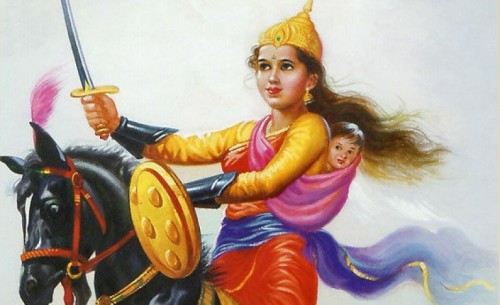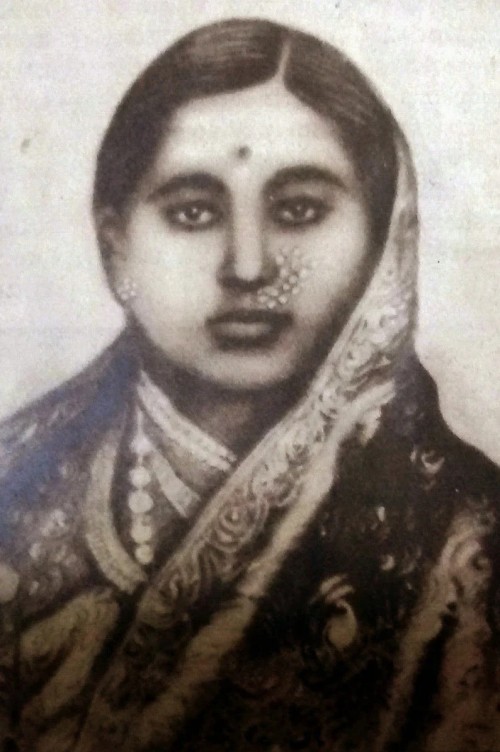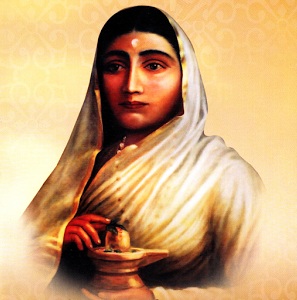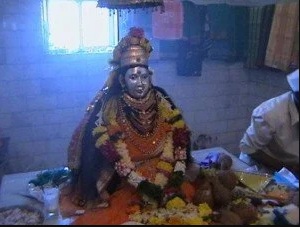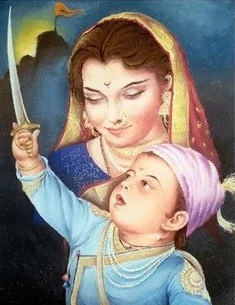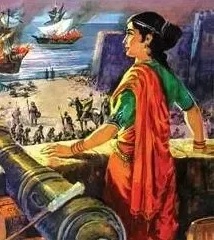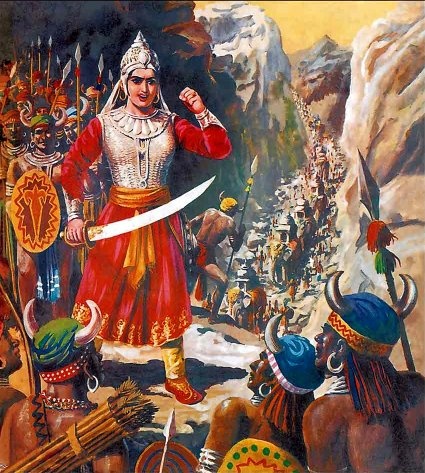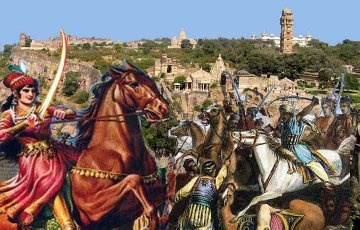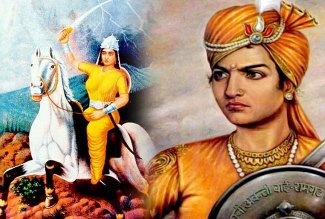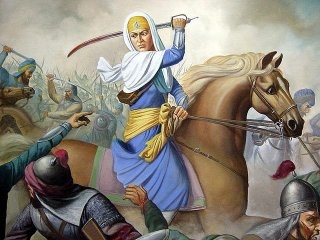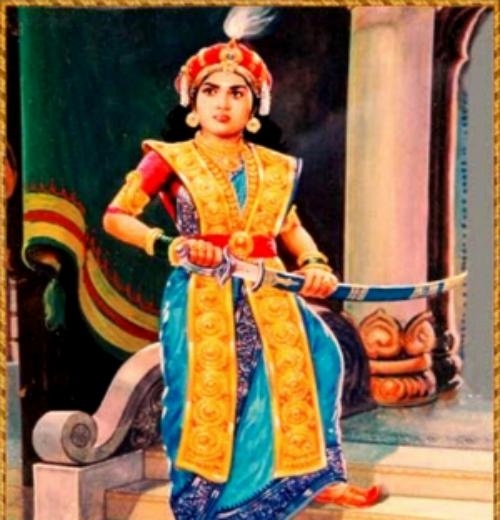
| BHARAT WOMEN WARRIORS In order to preach the eternal principles of Dharma and righteousness there have been numerous women saints, scholars, rulers and freedom fighters who have shone as a beacon of hope and courage under great odds to millions of women all over the world.This particular page is here to help educate others about the existence of women warriors throughout the span of time. Often women dove into battle to protect their land, homes, ideals or families, the same reasons men did.Today women still take up arms against enemies, remember the women of the past and present and let us keep their spirits alive within our hearts!
1. Rani Lakshmibai :
She was born on 19 November,1828 in a Brahmin family, at Kashi now know as Varanasi. Manikarnika was her first initial name but her family members called her Manu. She was trained in horse riding, shooting and fencing. She was very found of doing adventurous tasks since childhood. At the age of 16, she married Raja Gangadhar Rao, who was the then Maharaja of Jhansi. She gave birth to a boy child, unfortunately, the child not survived for a long time. Soon after the death of the child Raja Gangadhar Rao fell sick. Gangadhar’s health became very worse and died on November 21, 1853.
In those days British rulers brought an order that the kings who have no heir those kingdoms merge into British India, They have already decided to adopt Damodar Rao as their son for next heir to the Jhancy Kingdom. But Lord Dalhousie did not considered Damodar Rao as the legal heir of Jhansi due to the adoption.
Rani Jhansi was determined not to give up Jhansi. She strengthened its defences and assembled a volunteer army. Women were also given military training. Rani’s forces were joined by warriors including Gulam Gaus Khan, Dost Khan, Khuda Baksh, Lala Bhau Bakshi, Moti Bai, Sunder-Mundar, Kashi Bai, Deewan Raghunath Singh and Deewan Jawahar Singh.During this rebellion many British civilians, including women, and children were killed by the sepoys. The British wanted to end the rebellion quickly. Meanwhile, unrest began to spread throughout India and in May of 1857, the First War of Indian Independence erupted in numerous pockets across the northern subcontinent. She fiercely fought with British, finally British got victory in March, 1858. Then she moved Gwalior and met Tantya Tope for support to continue her fight against the British. Her brave and courageous fight encouraged many warriors in later years, however she lost her life in the battle of Gawlior on 18, June 1958.
2. Rani Padmini :
Padmini, also known as Padmavati, was a legendary 13th-14th century. Padmavati was the daughter of Gandharv Sen, the king of the Singhal kingdom. Rani Padmini was an Indian queen who ruled Chittorand by marrying King Rawal Ratan Singh. He defeated King Malkhan Singh and married her during a swayamvar. She was so beautiful that even Alauddin Khilji attacked Chittor in order to capture her. He only wanted to capture her for her beauty as her harem. The lustful Sultan was furious and ordered his army to storm Chittor. But hard as they tried the Sultans army could not break into the fort. Then Ala-ud-din decided to lay seige to the fort. The seige was a long drawn one and gradually supplied within the fort were depleted. Finally King Ratnasen gave orders that the Rajputs would open the gates and fight to finish with the besieging troops. On hearing of this decision, Padmini decided that with their men-folk going into the unequal struggle with the Sultan’s army in which they were sure to perish, the women of Chittor had either to commit suicides or face dishonour at the hands of the victorious enemy. A huge pyre (Jauhar) was lit and followed by their queen.
There are a number of contesting stories about Padmavati aka Padmini. While on the one hand, the Rajput community maintains the sanctity of everything related to her, historians often say that her life was nothing but a poet’s imagination.
3. Rani Chennamma :
She was born in the small village of Kakati in Belgaum, Karnataka in 1778. From a very young age she received training in sword fighting, archery and horse riding and got private lessons at home. Once King Mallasarja of Kittur was moving around trying to find support from neighbouring kingdoms to fight Tipu Sultan and approached Dhulappa Desai. He then saw Chennamma and was attracted to her confidence and bravery.Though he was already married and had a son Shivalinga Rudra Sarja, he took Chenamma as his second wife. They had a son who died at a young age. King Mallasarja also passed away. It is said that East India company’s collector and political agent Thackeray wished to capture Kittur to expand the British Empire. Rani Chennama now Queen of kittur decided to take charge and rallied together her trusted men to fight against the British. As a conclusion of this war British officers including Thackeray were killed. The remaining officials and soldiers were imprisoned and she ensured that they were treated with courtesy and kindness.
The British Empire was enraged at the humiliation of defeat at the hands of a small ruler and sent bigger armies to Kittur to capture it.. A fierce battle was fought but this time due to a number of traitors in her camp she lost the battle and was captured by the British and their treasury looted.
It is said that such was her indomitable courage and fearlessness that she tried to escape twice from the Kittur fort but was recaptured both times and then put in solitary confinement for life. She spent her days performing pooja and reading the holy texts till her death.In the year 1829 she died in confinement with the dream of a free Kittur in her heart and mind. Her burial place or Samadhi is at Bailhongal taluka surrounded by a small park.
Rani Chennama was a great example of this principle of real living by showing to the world that one woman could stand against the might of the British Empire for upholding justice and righteousness.A statue of Rani Chennamma was inaugurated in Parliament building in New Delhi in the year 2007 by the then president and prime minister. A number of memorials have been set up naming schools, parks etc in her name. Every year her legacy is commemorated from October 22 to 24 during the Kittur Utsav.
4. Ahilyabai Holkar :
She was born in the village of Chondi in Jamkhed, Ahmednagar in 1725, she was fondly referred to Rajmata Ahilyabai Holkar was the Holkar Queen of the Malwa kingdom. Her father, Mankoji Rao Shinde, was the Patil (chief) of the village. Her father home schooled her to read and write. She was married to Khanderao Holkar in 1733 at the tender age of 8.But unfortunately her husband Khanderao was killed in the battle of Kumbher in 1754, leaving her a widow at only 21. Ahilyabai’s only son Male Rao Holkar ascending the throne under her regency. Young monarch Male Rao too died, a few months into his rule, on 5 April 1767. Ahilyabai stood undeterred even after loosing her entire family.She did not let the grief of her loss affect the administration of the kingdom and the lives of her people. She took matters into her own hands. She petitioned the Peshwa after her son’s death, to take over the administration herself. She ascended the throne and became the ruler of Indore on 11 December 1767. The supreme ruler of the Empire, Peshwa Raghoba, was instigated by one of Ahilyabai’s own ministers to confiscate the excess wealth of Indore. Ahilyabai pointed out to him that under the agreements that existed the wealth of the treasury was supposed to be for the well being of her subjects or for charitable purposes.
The Peshwa was infuriated that she defied him, and threatened military action. She in turn challenged him to come and meet her on the battlefield. She gathered a small force, which included many women, and set out to fight. A message was sent to the Peshwa: “Now I will show you how weak I am. If I lose fighting against men I will have lost nothing. But if you lose against women then you will be in the soup! And remember, that is exactly what will happen.”
The Peshwa had a change of heart. He said, “You have misunderstood. I do not come to fight, but to mourn your son’s death.” He ended up staying as Ahilyabai’s guest for a month and was thoroughly impressed at the skill with which she ruled. For example, she had greatly reduced crime and theft, by encouraging poor people to get involved in trade and farming.At the age of 70 Ahilyabai passed away in Rameshwar. Her life shines brightly in the firmament of history, for ruling her kingdom with piety and selflessness; sincerely devoting herself to her subjects while keeping Dharma at the forefront of all that she did. Her life will be an inspiration for future generations of Hindus.
5. Akkadevi :
Akkadevi was well known for being an able administrator and capable general. She was a princess of the Chalukya dynasty of Karnataka and governor of an area known as Kishukadu, situated in the present day districts of Bidar, Bagalkot and Bijapur. Her life journey started from 1010 CE and ended in 1064 CE.
She was also called Gunadabedangi, meaning “beauty of virtues”. She was a lady of beauty with brains who governed KishuKadu as an adept general, administrator and a governor.In the course of Akkadevi’s rule, she expanded her province, encouraged education through grants, and gave liberally to Jain and Hindu temples. Akkadevi was said to be “a personage of great reputation and consequence”.An inscription dated 1022 calls her as courageous as Bhairavi in war.
6. Maharani Jijabai :
Jijabai was born in 1594 in the town of Sindhkhed in Maharashtra. Her father was an eminent Maratha Sardar and nobleman named Lakhuji Jadhavrao, while her mother was Malasa Bai. Her father served the NizamShahi of Ahmednagar and was proud of his high position and status. She tied the knot with Shahaji Bhosle, Together they had eight children, of whom six were daughters and two were sons, Shivaji being one of them, the legendary Maratha king and warrior who stood strong against the rivaling Mughal Empire.
Jijabai remained with her husband at the Fort of Shivneri, devotedly standing by his side; however, she was disappointed with the fact that both he and her father served under other rulers, while she longed for freedom under a kingdom founded by the Marathas themselves.Jijabai was known to be an influential and determined woman who was an embodiment of self-respect and virtue.
7. Abbakka Rani :
Abbakka Rani was the queen of Tulunadu who fought the Portuguese in the latter half of the 16th century. She belonged to the Chowta dynasty who ruled over the area from the temple town of Moodabidri. The port town of Ullal served as their subsidiary capital.
•
The first attack by the Portuguese in south Kanara coast was in
1525, when they destroyed the Mangalore port. Rani Abbakka was alerted
by the incident and started preparing herself to protect her kingdom.
8. Rani Durgawati :
Born to Keerat Rai, the chandel king of Kalinjar, Durgavati was married to Dalpat Shah of Gondwana of Rajgond dynasty. She inherited the throne after her husband and successfully defended gondwana from the attacks of sultans of Malwa. She repelled mughal army three times but at last her army consisting of tribals with primitive weapons failed to stop the mighty mughals. She killed herself at last of the battle.
9. Rani Jawahar Bai :
Daughter in law of Rana Sanga and wife of the most unpopular king Vikramaditya of Mewar , Jawahar bai was a well trained worrior. She refused to do Jauhar and fought against army of Gujarat sultanate. She sacrificed her life for the protection of Mewar and chittorgarh.
10. Rudramma devi :
Daughter of Kakatiya king of Warangal , she inherited the throne after her father and successfully defeated Yadavs of Deogiri and forced them to surrender a large number of territories. She stopped the Gangas of Odisha to the north of Godavari.
11. Rani Avanti bai :
She was wife of Vikramaditya Singh of Ramgarh and was denied the throne after his death. During the revolt of 1857, she successfully attacked the Britishers and gained control of several territories. But her rule did not last longer than four months. The Britishers were set to regain control with her efforts of reorganising her army failing miserably. She died a tragic death. In order to save her honour and avoid being captured, she stabbed herself with her own sword.
12. Tara Rani Sahib :
Tara Bai was wife of chatrapati Rajaram , who lead the Marathas after his death. Tara bai was an able administrator as well as a brave warrior. She continued the Maratha-Mughal wars for years until shahuji returned from Agra.
13. Bibi Sharan Kaur :
Originally a simple lady who was going to husband's house after marriage, and then she was attacked by pathans. Some Sikhs saved her and she decided to become a sikh warrior. She fought many battles and worked as a spy for Sardar Hari Singh Nalwa.
13. Onake obavva :
Onake Obavva was a woman who fought the forces of Hyder Ali single-handedly with a pestle (Onake) in the kingdom of Chitradurga of Karnataka, India. Her husband was a guard of a watchtower in the rocky fort of Chitradurga. She killed many soldiers of Haider Ali with the pestle but was found dead on the same day.
14. Maharani Tarabai :
Wife of the third Maratha Chhatrapati Rajaram, she was the daughter of Prataprao Gujar, once Commander-in-chief of Shivaji Maharaj.
Following the death of Shivaji, Aurangzeb initiated a big Deccan expedition. He was resisted bitterly by the Marathas, first under Sambhaji and later Rajaram, the second son of Shivaji. After Rajaram's death in 1700, she proclaimed her infant son as the successor and herself as the regent, and against all odds, spearheaded the resistance against a mighty foe.
She was well versed in the art of war. She herself took lead in various battles, and made strategic movements. For seven years, she carried the struggle. The Mughals were heavily bleeded from a prolonged strife. Death of Aurangzeb in 1707 ended the 27-year long war.
Return of Shahu: Shahu was the son of Sambhaji, imprisoned by the Mughals when seven, was released (aged 25) to divide the Maratha onslaught. He instantly claimed the throne, which Tarabai denied. Due to his lineage and Balaji Vishwanath's diplomacy, many generals went over to Shahu. Tarabai opposed him, but Shahu prevailed. She established a rival court in Kolhapur in 1709, but was deposed again. After Shahu's death, she had a big influence on the Empire.
In words of Jadunath Sarkar, 'It is her character that saved the nation in that awful crisis.
15. Rani Karnavati :
Rani Karnavati also known as “Nak kati Rani” ruled in the Garhwal region of Uttarakhad state. In 1631 Rani Karnavati’s husband ‘Mahipati Shah’ died in a fierce battle between the kingdom of Garhwal and Kumaon , at that time his son was only 7 year old. Hence, queen of Mahipati Shah took over the administration. She ruled over for many years to come, during which she successfully defended the kingdom against invaders and repelled attack of Mughal army of Shah Jahan led by Najabat Khan in 1640.
During that period, the Mughals were ruling over a very big part of India, as Garhwal kingdom was very close to Delhi so a attack was inevitable .
The Mughal army was well equipped for the war and the only thing they lacked was the experience of fighting the enemy in the tough Himalayan mountains. Shahjahan who was the Mughal emperor was well aware that Mahapati Shah, the king of Garhwal kingdom had died and a lady was sitting on the throne so nobody could stop their army from attacking the kingdom. He then handed his army’s command to Najawat Khan for attacking the Garhwal Kingdom.
The Mughal army crossed the Ganga River at Haridwar from where they march towards Srinagar Garhwal. The Mughal army was so confident by their recent wins that they entered the region marked by Rani Karnavati.
Rani Karnavati instructed her commander Dost Beg to build hurdles on the route from where the Mughal army was marching. On every mile, the Mughal army has to cross a wall of stones and fallen trees. It not only wasted their time and energy but also distributed them in small troops. Meanwhile, on the other side the gorilla Garhwal soldiers attacked them in the speed of thunder and after the attack, they used to hide quickly. Because of this ambush, the Mughal army became terrified of the Garhwal army as they repeatedly attacked the Mughal troops whenever they had the opportunity. Since the Mughal army was naive to this place they couldn’t gave a strong fight.
Soon the monsoon started and the rain worsened the situation, the nights became ghosts for the Mughal soldiers and a few days journey seemed like a never-ending gradient. Taking advantage of the moment, Rani Karnavati ordered her army to attack the Mughal battalions with full force. The Garhwal army obeyed her orders and erased the Mughal soldiers. Some of them died, some fled from the war zone to save their life and some jumped into the river Alaknanda and drowned in the river eventually. As per the orders of Rani Karnavati the remaining Mughal army soldiers were captured by the Garhwal army as and their noses were cut off and the message was conveyed
“ The sword which could cut noses could cut heads too”
hence she became famous as “Nak kati Rani”. In this way the Mughal advance into the mountain passes was restrained by the fierce Queen
She is also credited with the construction of the Rajpur Canal, the earliest of all the Dun canals, which starts from the Rispana river and brings its waters till the city of Dehradun.
16. Velunachiyar :
Velunachiyar was an 18th century Tamil queen from Shivganga. Velu Nachiyar was the first Queen to fight against the British in India, even preceding the famous Rani Laxmibai of Jhansi.
She was trained in the skills of using weapons and also in martial arts including fencing, shedding arrow, spear throwing, horse riding and archery. All of which helped her in later parts of her life. Apart from heroic arts & sports, she knew ten languages. The young woman who grew up with valor and bravery, met a turning point in her life.
Muthuvaduganathar, King of Shivganga married Velunachiyar in the year 1746 inspired by her beauty and bravery. The Nawab of Arcot along with the British conquered Ramanathapuram and their next target was Shivganga. “Chinna Maruthu” and “Periya Maruthu” known for their bravery were the combat commanders of the King and Queen. King Muthuvaduganathar was killed in Kalaiyar koil by the British troops and Nawab of Arcot in 25.06.1772.
Velunachiyar decided to take revenge on the British for killing her husband and capturing her kingdom. Dalavay Thandavaraya Pillai and Maruthu brothers promised to recapture the kingdom to punish the English. Velunachiyar moved to different places often in order to avoid British invaders. Meanwhile Velunachiyar wrote a letter to Sultan Hyder Ali seeking his help. Since she didn’t get a reply from him, she decided to meet Hyder Ali face to face. She explained in detail all her problems with East India Company to Hyder Ali in Urdu. She explained him her strong opposition of British regime. Hyder Ali was very much pleased and promised to help her in this conflict. He accepted her request with sympathy and provided the necessary military Assistance. He ordered to provide the required military equipment to Queen Velu Nachiyar.
After forming an Army, Velunachiyar and her troops advanced to Shivganga with the help provided by Maruthu brothers. They geared up the troops and entered Shivganga. When Velu Nachiyar found the place where the British stored their ammunition, she arranged a suicide attack. Her faithful follower, Kuyili, doused herself in oil, set herself alight and walked into the storehouse. Velu Nachiyar formed a woman's army named "udaiyaal" in honour of her adopted daughter, Udaiyaal, who died detonating a British arsenal.
She defeated the Nawab of Arcot and took him as a captivator. She re-captured Shivganga and crowned herself as the Queen of the Shivgangai Seemai. Velunachiyar mounted the flag of Hanuman over the castle.
Nachiyar was one of the few rulers who regained her kingdom, and ruled it for ten more years. She granted powers to the Marudu brothers to administer the country in 1780. In 1790, the throne was inherited by her daughter Vellacci.
Source :
https://www.reckontalk.com/
https://www.quora.com/Other- |
